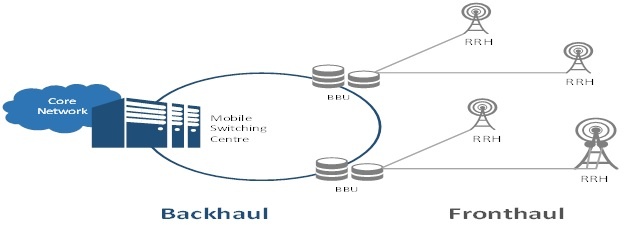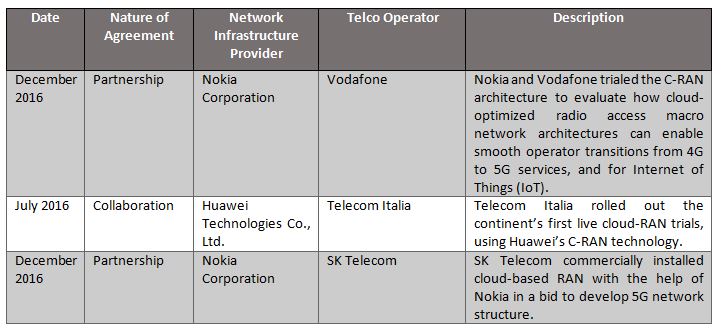Some of the biggest challenges faced by the telecom industry include the growing number of subscribers and user database, the ever-increasing data transmission rate, and providing latent-free services to end-users. In order to tackle these issues, telco providers and networking infrastructure providers jointly came up with the heterogeneous network (HetNet) model, which encompasses components such as small cell, Distributed Antenna System (DAS), and Radio Access Network (RAN).
The basic components of RAN technology encompass antennas, Radio Frequency (RF) processing, and Base Band Units (BBU) for digital processing and transport. The RAN technology evolved from the traditional base stations to distributed base stations, followed by centralized based station or Centralized RAN (C-RAN).
Deployment C-RAN is at the epicenter of the fronthaul and backhaul units (Fig 1). Fronthaul is the connection between Remote Radio Head (RRH) and BBU, connected through Common Public Radio Interface (CPRI) or Open Base Station Architecture Initiative (OBSAI). Whereas, backhaul implies the linkage between BBU and the core network, often through coax fibers or wireless communication channels.
 Fig 1 – Source: Ciena Corporation
Fig 1 – Source: Ciena Corporation
The figure given below (Fig 2) illustrates the evolution of C-RAN, wherein under the distributed RAN, RRH with individual BBUs is used as a signal interference from the mobile device. Whereas, the C-RAN technology pools the already existing BBUs and merges with the array of RRHs across the cells. This has considerably reduced the overall performance of signal interference tackling the latency issues to a great extent.
 Fig 2 - Source: Nokia Corporation
Fig 2 - Source: Nokia Corporation
Virtualization is another concept gaining wide-scale recommendation in the field of C-RAN, which is also termed FlexRAN. The architecture layer-3 and S1- U layers are hosted on centralized IT servers, which are connected to antennas over the Ethernet.
Commercial deployment of C-RAN has been practiced for the past 10–12 months. A large number of networking infrastructure providers, such as Nokia Corporation, Cisco Systems, Inc., and Ericsson AB are teaming up with growing Mobile Network Operators (MNO), such as Verizon Communications, AT&T, Vodafone, and SK Telecom to enhance the deployment rate. Some of the major partnerships include:

Fig 3 - Source: Press Release
Network virtualization is gaining significant attention in the telecommunication industry. This has considerably reduced the Total Cost of Ownership (TCO) of telecom operators, the Capital Expenditure (CAPEX), as well as, the Operational Expenditure (OPEX) to a great extent. As the deployment of networking infrastructure is virtual, there has been an increased scalability to address the network requirements.
C-RAN is capable of offering third-party edge services to provide localized communication service in connection with Mobile Edge Computing (MEC). The evolution of 5G is expected to boost the market and bring about significant growth characteristics in the telecom industry. So far, most of the blue chip companies have undertaken C-RAN as a part of their R&D prospects. Moreover, network infrastructure providers have targeted telco operators to test their products.
As a large number of developing countries are expected to witness the 5G rollout over the coming years, the deployment of C-RAN is expected to gain momentum post full-fledged Long-Term Evolution (LTE) (4G) deployment. The cutting-edge technology for C-RAN basically used for the reutilization of the existing infrastructure, without increasing the OPEX. As per MarketsandMarkets analysis, C-RAN technology is at a very nascent stage and is expected to attain significant growth rate post-2020 in developing economies.
The major players in the C-RAN market include Nokia Corporation, Huawei Technologies Co. Ltd., Cisco Systems, Inc., Ericsson AB, Samsung Electronics Co Ltd, Fujitsu, ZTE Corporation, and NEC Corporation. Significant developments were noticed in the C-RAN market by the above-mentioned players, enabling us to position them as visionary leaders and dynamic differentiators under the C-RAN market MarketsandMarkets’ MicroQuadrant.
A detailed analysis of the report with respect to market sizing, competitive scenarios, and regional trends is available in the below mentioned link:
For further telecom infrastructure-related reports, kindly refer to the below links:
- Mobile and Wireless Backhaul Market - Worldwide Market Forecasts and Analysis 2015-2020
- Small Cell Networks Market - Global Forecast to 2020
About the Author: Dhaval Kate is a Senior Analyst (ICT domain) at MarketsandMarkets.


